Marketing 101: A beginner’s guide to marketing fundamentals
Sponsored by Semrush, edited by Nichola Stott
If you’re new to marketing, it’s important to understand the basics.
That’s exactly what you’ll get in this article: a comprehensive marketing 101 discussion.
Let’s start.
What is marketing?
Marketing is the process of attracting potential customers to your products or services. And involves understanding your audience’s wants, creating value for them, and building long-term relationships.
The purpose of marketing is to:
- Create brand awareness
- Generate leads (qualified prospects)
- Convert leads into customers
- Foster loyalty that leads to repeat business
- Drive revenue
Digital marketing vs. traditional marketing
Traditional marketing focuses on reaching audiences through offline channels. Such as print ads, billboards, TV commercials, and direct mail.
Digital marketing uses online channels like social media, search engines, and emails to reach prospects.
While traditional marketing is still relevant (particularly for growing brand awareness), digital marketing offers more precise targeting, can be more accurately measured, and is easier to scale.
For example, we know from Traffic Analytics data that the Semrush website attracts over 33 million monthly visitors. And that many of them come via digital marketing efforts.
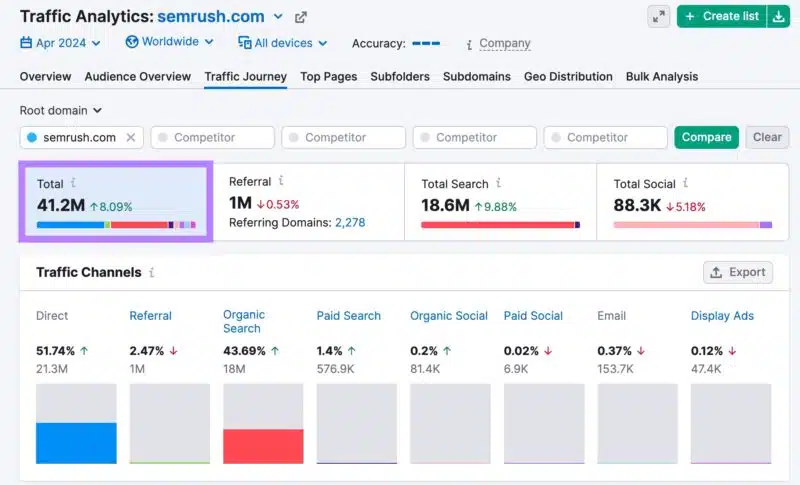
What are the fundamental elements in marketing?
Professor E. Jerome McCarthy introduced the four Ps framework (product, price, place, and promotion) in the book “Basic Marketing: A Managerial Approach” in 1960. To outline the key elements that impact your marketing strategy.
But it’s equally relevant for modern marketing. Because you need to have a deep understanding of these elements to meet customer needs and business goals.
So, let’s go over them:
Product (or service)
Product or service refers to what you’re offering to the market. And who you’re trying to reach.
As a marketer, you must understand your products or services well—the benefits, features, etc.—so you can:
- Communicate why you’re better than competitors
- Communicate customer expectations (or gaps) to other relevant teams at your company
Because marketing is as much about co-creating and improving your product or service as it is about communicating its benefits to customers.
Price
Pricing is how much your products or services will cost. And it’s important to get it right.
If your prices are too high, customers might find them unaffordable.
But if your prices are too low, customers may think what you offer isn’t of good quality.
So, you must strike a balance to attract customers while also ensuring profitability.
Some other factors that influence pricing decisions include production costs, market demand, and competitor pricing.
Place
Place refers to where customers can find and buy your products or services. Which could be online, at a physical location, or both.
For instance, consider a company that sells both high-end athletic apparel and budget-friendly activewear.
Their high-end line targets affluent consumers. So, they might have boutique stores in upscale shopping districts for that product line.
But for their budget line, placing those products in big-box retailers and discount chains makes more sense.
Promotion
Promotion is about reaching your customers:
- At the right time: For example, promoting skiing gear makes most sense during the pre-season (when skiing enthusiasts plan their ski trips). And during the peak season (when active skiers may need new equipment or replacements).
- At the right place: For example, if your target audience is senior executives, LinkedIn could be a better social platform than TikTok
- With the right message: For example, a user who just signed up for your free software plan will probably be more receptive to emails linking to tutorials than to prompts to upgrade their plan
With the right approach to promotion, you can effectively engage your audience. And drive better results from your marketing efforts.
What are some key digital marketing channels?
To optimize your reach and audience engagement, use a combination of marketing channels that aligns with your audience’s preferences.
Here’s an overview of some of the popular marketing channels:
Search engine marketing
Search engine marketing (SEM) is about promoting your brand, website, or products on search engines. So you can reach people actively searching for topics related to your brand.
There are two ways to do this: search engine optimization (SEO) and pay-per-click (PPC) advertising.
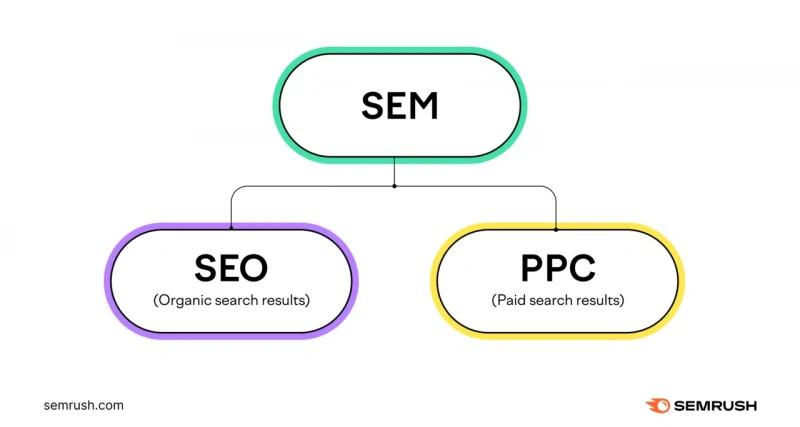
When potential customers use search, they can see both types of results.
Organic (SEO) results are those the search engine deemed highly relevant to the search terms. Paid results include search ads companies paid to show in the sponsored section.
This is what paid and organic results look like:
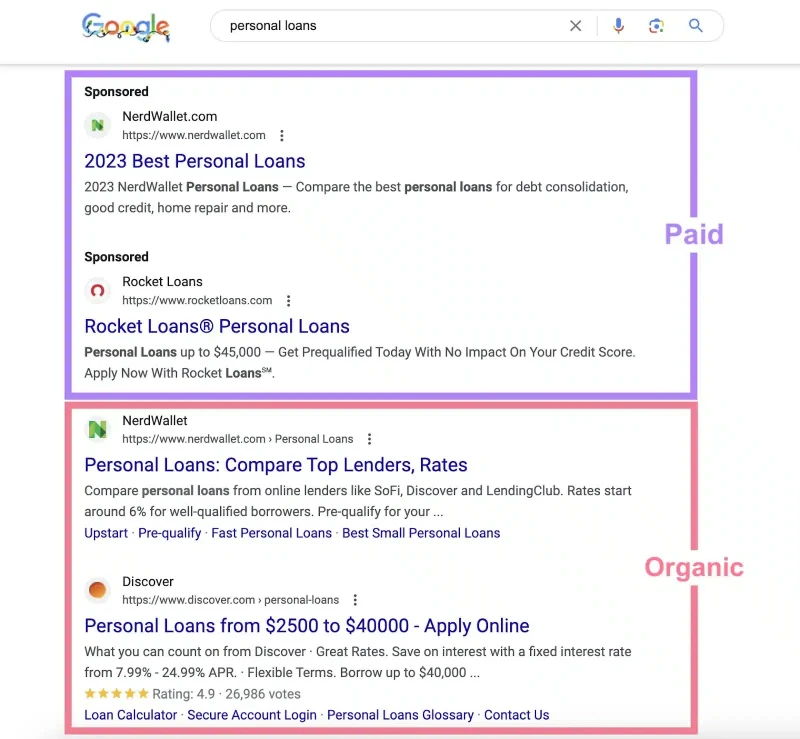
It may take time to see significant results from SEO. But it can give you exponential and recurring traffic (as well as revenue) in the long run.
But PPC can provide more immediate visibility and traction.
So, it’s a good idea to combine both. And you can get started by conducting keyword research.
Here’s how you can do that with Semrush’s Keyword Overview tool.
Launch the tool, enter a term related to your business, enter your domain to see personalized data for your site, and hit “Search.”
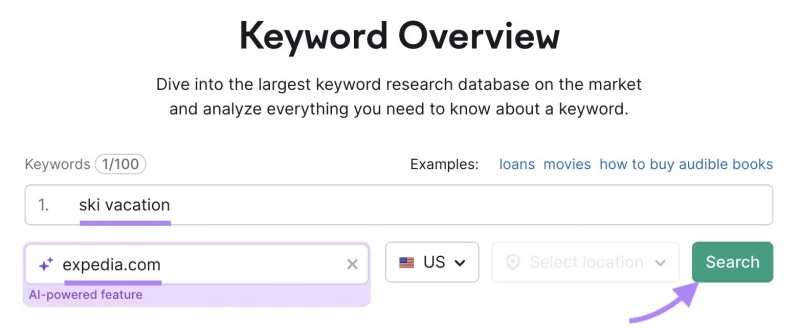
You’ll see data such as:
- Volume: The average number of monthly searches for the keyword
- Keyword Difficulty: A measure of how difficult it is to rank for the specified term
- Personal Keyword Difficulty: A measure of how difficult it is for your specific site to rank for the specified term
- Intent: The main reason or motivation behind the search query
- Trend: How search volume has changed over the last 12 months
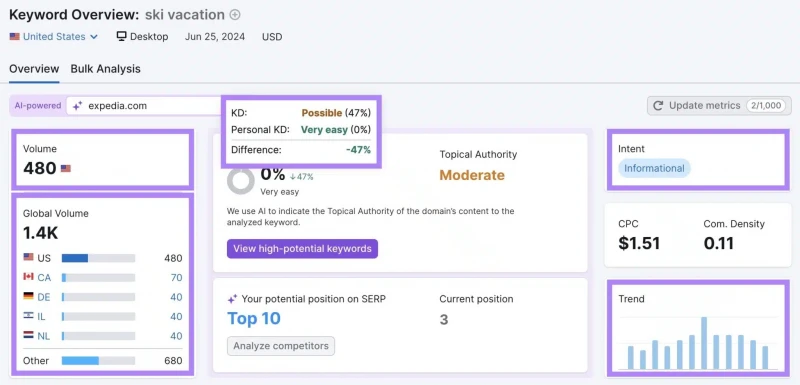
Scroll down to the “Keyword ideas” widget.
You’ll see:
- Keyword Variations: Keywords related to the target query
- Questions: Related questions or phrases people frequently search online
- Keyword Strategy: An AI-generated personalized content plan for your site
Click the corresponding “View all” link in these sections to get some more specific keyword ideas you can leverage for your SEO and PPC efforts.

Social media marketing
Social media marketing refers to using social platforms like Facebook, Instagram, Pinterest, LinkedIn, and TikTok to connect with your audience.
Over 5 billion people (nearly 63% of the world’s population) use social media. This makes it a crucial marketing channel for pretty much any business.
Just like with search engines, you can reach your audience in two ways: organic social and paid social.
Here’s an example of organic content from GoPro:

By sharing engaging content like this, you help build brand loyalty. And drive traffic to your website.
You can also use social platforms to advertise your products and services.
For instance, LinkedIn Ads can be very effective for B2B companies.
Take a look at this LinkedIn ad from Mixpanel (product analytics software).
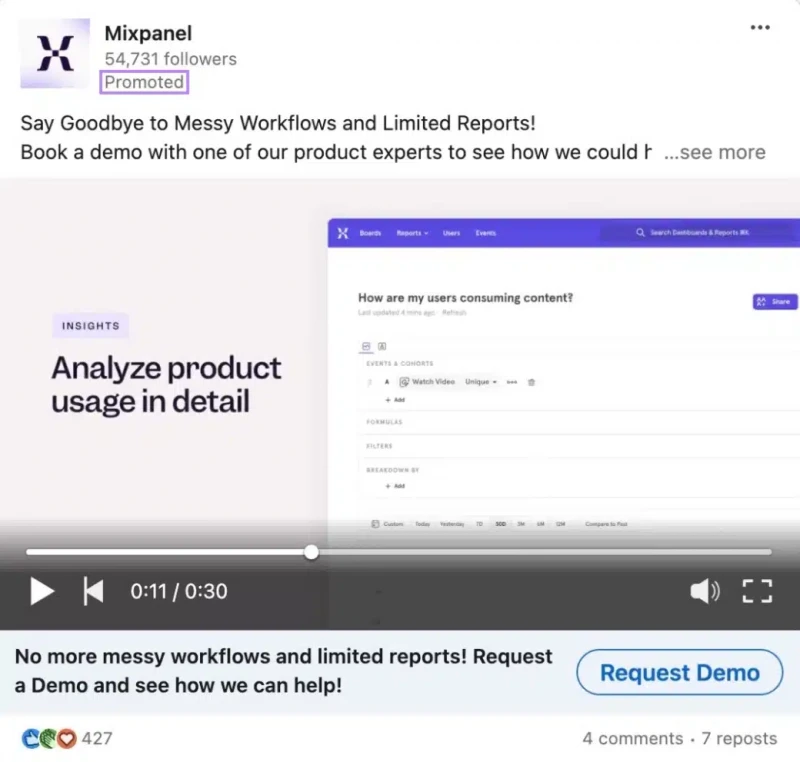
When you’re ready to get started, use Semrush Social to manage your social profiles, track competitors’ strategies, and monitor important KPIs.
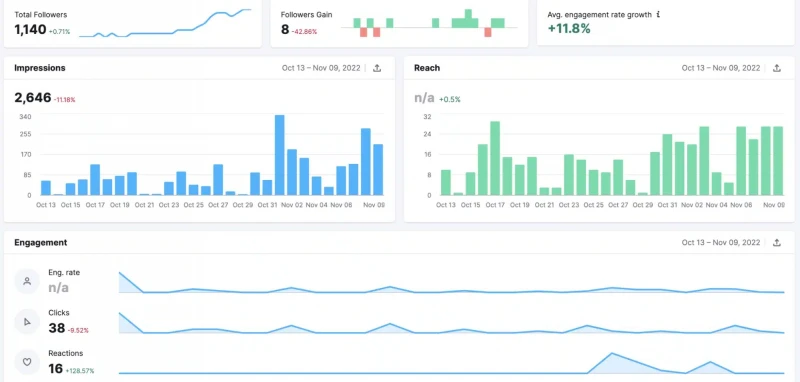
Email marketing
Email marketing involves sending emails to subscribers to showcase valuable content, promote new products/services, etc. And it tends to generate great returns.
Research from Litmus shows email marketing generates between $32 and $45 for each dollar spent.
Some common email types include:
- Welcome emails: To greet new subscribers or buyers. And set expectations for future interactions.
- Promotional emails: To inform customers about special deals or new product launches. These can help you increase sales.
- Newsletters: To keep your audience informed about your business, industry developments, or other initiatives
- Re-engagement emails: To re-capture the attention of subscribers who’ve stopped interacting with you
Here’s an example of a welcome email from cat food brand Smalls:

Image Source: Really Good Emails
Follow these tips for effective email marketing:
- Personalize your emails by using the recipient’s name and tailoring the content to their interests. You can do that with email automation tools like MailChimp and ConvertKit.
- Write compelling subject lines to increase open rates. And leverage creative body copy to grab your audience’s attention.
- Segment your email list based on subscribers’ demographics, behavior, or preferences for precise targeting
- Include clear calls to action (CTAs) that guide recipients to take the next step
- Ensure your emails are mobile-friendly. Because many users read emails on their phones.
5 Marketing tips to get started
1. Research your target audience
Knowing your target audience allows you to tailor your marketing efforts to meet their specific needs.
It helps you create relevant content, choose the right marketing channels, and refine your products or services to better resonate with them.
This leads to increased engagement, conversion, and retention.
Start your audience research process by using One2Target.
Open the tool and enter a competitor’s domain name. And click “Analyze.”

In the default “Demographics” overview tab, you’ll see the audience distribution based on their age group and gender.

Scroll down to see their website traffic distribution by country. Like this:
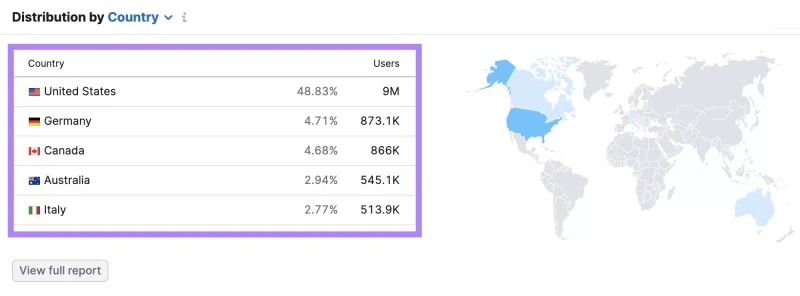
This helps you identify the major markets for your products or services.
Next, click on the “Socioeconomics” tab.
Here, you’ll get data like the average household size, income level, education, and employment status.
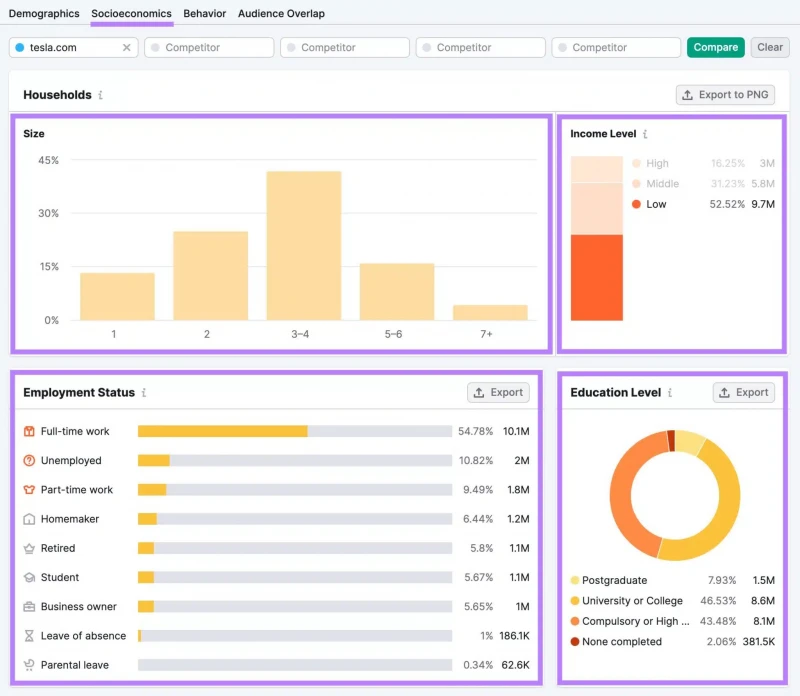
This data can give you an idea about your audience’s financial responsibilities and ability to spend. Which can guide your pricing and targeting decisions.
Next, head to the “Behavior” tab to understand your customers’ interests. And media preferences.
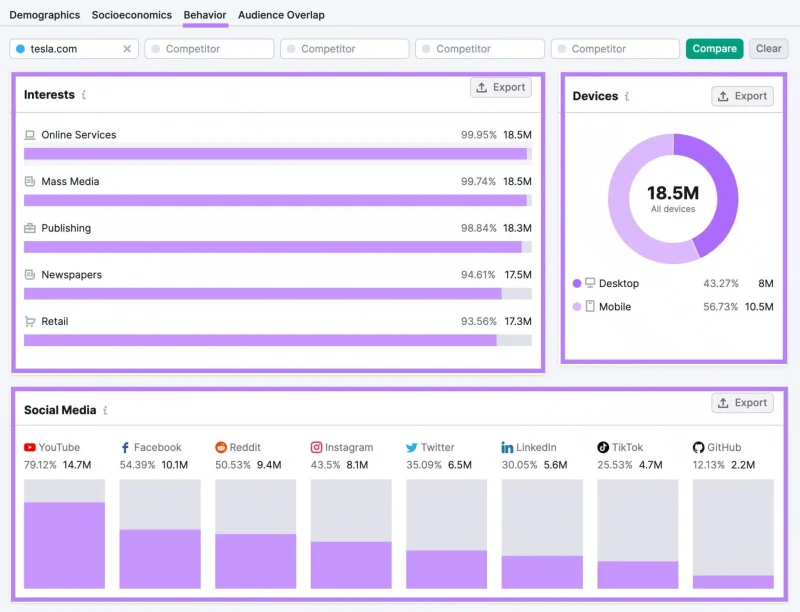
This data gives you an idea of the platforms your audience uses. So you can decide on your marketing channels accordingly.
Based on data collected from your audience research, create detailed buyer personas (ideal customer profiles). And plan your marketing campaigns with them in mind.
2. Analyze your competitors
Next, research your competitors by analyzing their products and their marketing, sales, and operations strategies. To discover their strengths and weaknesses.
It also helps you:
- Identify gaps in your strategies
- Anticipate your competitors’ next moves to stay ahead of them
- Gain insights to better position your business
Start by identifying your main competitors. Look at businesses that offer similar products and target the same audience.
Or, simply use Market Explorer.
Launch the tool and select “Find Competitors.” Enter your domain and click the “Research a market” button.

The default “Overview” tab will show you the “Market Summary.” This includes the list of main online competitors, their market share, audience size, and more.
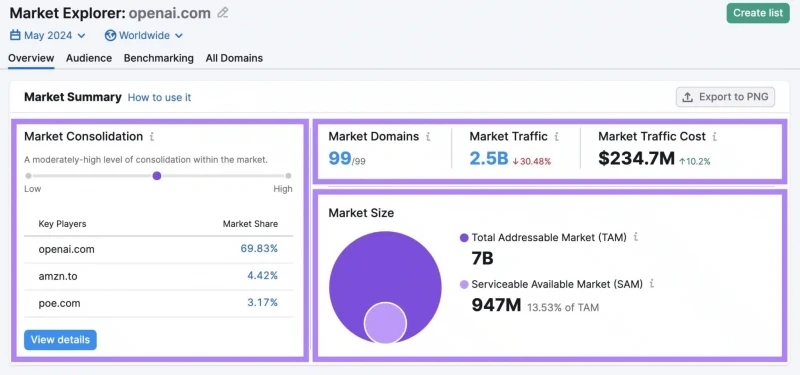
Next, scroll to the “Growth Quadrant” widget.
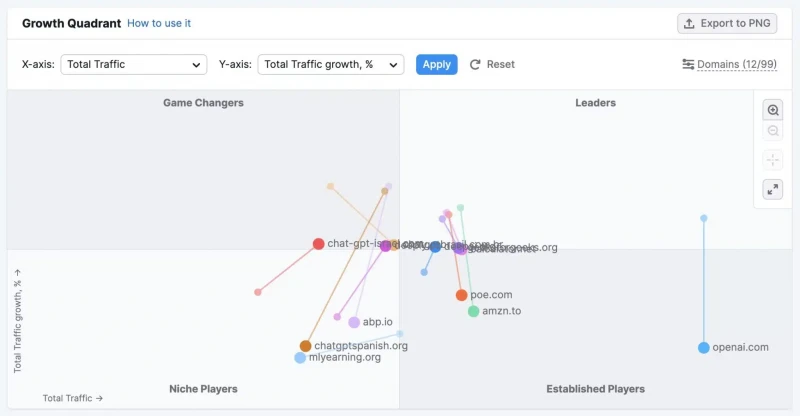
It divides the competing websites into four categories:
- Leaders: High traffic, high growth rate
- Established Players: High traffic, low growth rate
- Game Changers: Low traffic, high growth rate
- Niche Players: Low traffic, low growth rate
Make note of how you compare to your rivals in the Growth Quadrant. And list your three to five main competitors.
Then, use this free Competitive Analysis Template to fill in your competitors’ data.
Finally, follow these steps:
- Examine the competitor company profiles. Check their profitability, employee count, etc.
- Analyze their products and services. Look at the features, pricing, quality, etc.
- Study their marketing mix. Analyze their product, pricing, placement, and promotion strategies. Look at marketing channels, tactics, traffic sources, social media activities, etc.
- Evaluate customer feedback. Read customer reviews and testimonials to understand what customers like and dislike about your competitors
- Perform a SWOT analysis. List each competitor’s strengths, opportunities, weaknesses, and threats. And compare them against your business.
3. Craft a unique value proposition to differentiate your business
A value proposition is a concise statement that explains how your products or services solve a specific problem or benefit customers.
In short: It tells customers why they should choose you over the competition.
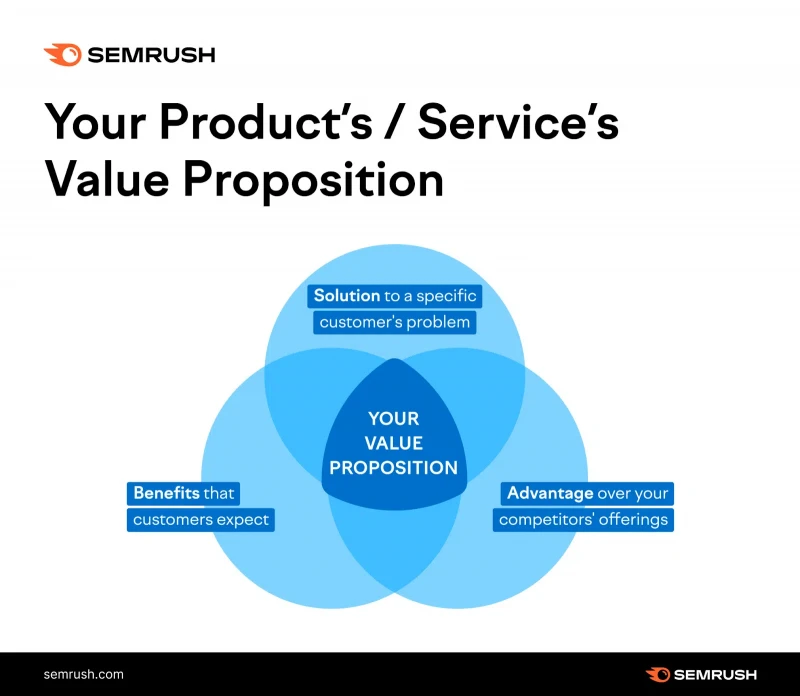
For example, here’s Shopify’s value proposition:
“Making Commerce Better for Everyone. Shopify is supporting the next generation of entrepreneurs, the world’s biggest brands, and everyone in between.”

Here are some tips to help you create a compelling value proposition:
- Address your customer’s pain points. Use your research to understand your target audience’s challenges. And mention how your products or services solve them in your messaging.
- Highlight key benefits. Share the main benefits of using your products or services, including how you differ from competitors. Don’t just list features—explain how they provide value.
- Be clear and concise. Keep your value proposition simple and easy to understand. Avoid jargon and complex language.
- Test and iterate. Test your value proposition with a small sample from your audience. Check whether it resonates with them. And refine it based on the feedback you receive.
4. Document your marketing strategy
A documented strategy provides a clear roadmap for your marketing activities. And also keeps your team and marketing goals aligned with your business goals.
Let’s look at the key components of a marketing strategy document:
- Market research: Detailed insights into your target audience, market trends, and competitive landscape
- Goals: Marketing goals that align with your business goals. These should be SMART (specific, measurable, achievable, relevant, and time-bound) goals.
- Unique value proposition: A clear statement of what makes your product sor services unique and why customers should choose you over competitors
- Marketing channels: The platforms and channels you’ll use to reach your target audience (e.g., social media, email marketing, content marketing, SEO, and PPC)
- Budget: An overview of your marketing budget. With a breakup of the allocated budget for different channels and activities.
- Marketing plan: A detailed action plan of the specific marketing activities and tactics you’ll implement to achieve your goals. This should include timelines, responsibilities, and key milestones.
- Marketing KPIs: The key performance indicators (KPIs) you’ll use to measure the success of your marketing efforts. This may include website traffic, conversion rates, engagement metrics, and return on investment (ROI).
Tip Use the AI Marketing Strategy app to access frameworks for marketing planning for every stage of the marketing funnel. And get access to an AI tool that generates copy, graphics, and more.

5. Create a marketing calendar for consistent execution
A marketing calendar outlines all your marketing tasks and their deadlines. To help your team execute the tasks and track the progress.
Here’s what it can look like:
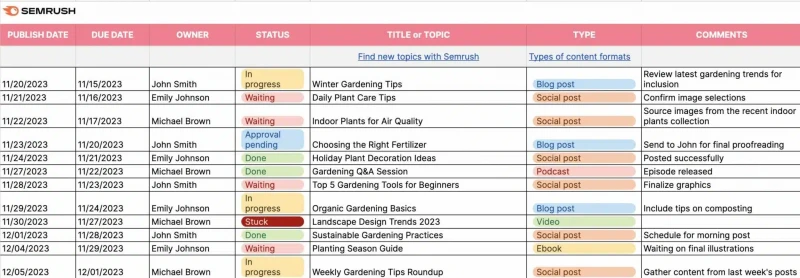
Consider these tips to create an effective marketing calendar:
- Plan your content. Decide on the content topics and formats (e.g., blog posts, social media posts, email campaigns, and videos)
- Schedule your activities. Assign specific deadlines for each marketing activity. Be realistic about the time needed for planning, creation, approval, and distribution.
- Assign responsibilities. Clearly define who’s responsible for each task. This ensures accountability and helps avoid confusion.
- Use tools. Improve team collaboration with marketing calendar tools or project management software like Trello, Monday, or Asana
Track and optimize your marketing efforts
Marketing success often comes from measuring results and iterating.
So, regularly monitor your results. To find out what’s working and what needs to be adjusted.
If you’re focusing on SEO, you can do this with Position Tracking. Which lets you track your keyword rankings and get notified when there’s a significant change in positions
Access this and numerous other tools with Semrush.